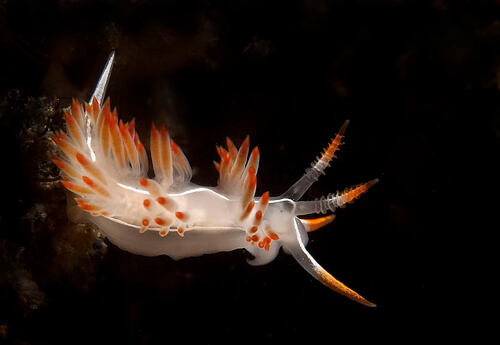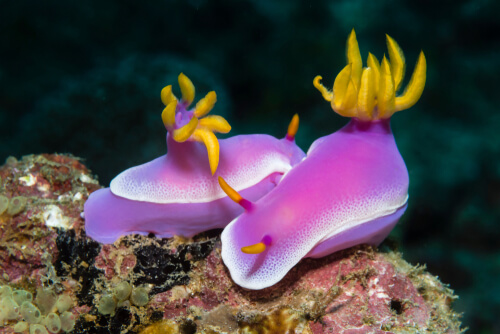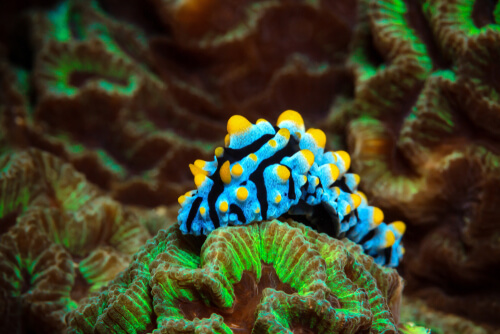
| Kingdom | Animalia |
| Phylum | Mollusca |
| Class | Gastropoda |
| Order | Nudibranchia |
| Clades | Euctenidiacea, Dexiarchia |
| Species | 3000+ species |
| Niche | Marine gastropod |
| Length | 0.16-23.62 in (4-600 mm) |
| Lifespan | Up to one year |
| Social Structure | Mostly solitary |
| Conservation Status | Not evaluated |
| Preferred Habitat | Coral, rocky reefs |
| Average Number of Eggs | Varies widely (1-25 million) |
| Main Prey Species | Sponge, algae, hydrozoans, etc. |
| Predators | Various |
The Basics
Nudibranchs are an order of marine gastropod consisting of more than 3,000 species. They are soft-bodied, slug-like animals many of which are adorned with bright colors and extravagant body forms. Most nudibranch species live on reefs in temperate and tropical seas and are a popular species to observe by SCUBA divers around the world.
Description
With so many species of nudibranch, their forms are very diverse. The smallest species is just 0.16 in (4 mm) long while the largest species can grow up to 23 in (60 cm) long. They all have small, simple eyes set into their bodies that are able to do little more than discern various levels of light.
Nudibranchs are named after the Latin word nudus meaning ‘naked’ and the greek bránkhia meaning ‘gills’. This is in reference to the fact that dorid nudibranch species breathe through a ‘naked gill’ shaped into branchial plumes – much like the alveoli of a human lung – but external to their bodies.
Distribution, Range, and Habitat
Nudibranchs can be found in oceans around the world, even in the Arctic and Antarctic. The largest diversity of nudibranchs occurs in warm waters on shallow reefs, although a recently discovered species was found at more than 8 200 ft (2 500 m). Most nudibranchs are benthic, crawling around on the seafloor or reef rather than swimming, in the water column. However, during their larval stages, most species are planktonic. They have tentacles on their heads that act as sensory organs and are sensitive to touch, taste, and smell as they move across the substrate in search of food and mates.

Diet and Predators
Most nudibranch species have simple guts and mouths featuring a radula – a simple, tongue-like organ that helps to eat. Nudibranchs are carnivorous predators, typically feeding on various species of sea sponges. Their specific diet depends on the species itself and the environment it inhabits, and many have formed close evolutionary relationships with their prey.
Nudibranchs are susceptible to a wide host of marine animals. However, they have developed various unique and effective defense strategies that help them to avoid predation as much as possible. Some have evolved to appear like their prey, marine sponges, and thus avoid detection by a predator through camouflage. In other species, the opposite is true, and they have intensely bright colors and patterns, warning predators of their chemical defenses that most predators such as fish do not find edible.
Perhaps even more fascinatingly, some nudibranchs that feed on hydrozoids, a family of sedentary animals related to jellyfish, can store the stinging cells of the hydrozoid in their own skin. They pass through the nudibranch’s digestive system without harming it and then are concentrated in the animal’s hind end. Any animal that tries to bite one of these nudibranchs will receive a painful sting and will likely not go near one again.
Reproduction
In all nudibranchs, which have both female and male sex organs, the sexual openings are on the right side of the body. However, they still require a mate in order to reproduce, as they are not able to self-fertilize. Following a dance-like courtship, two nudibranchs will cross-fertilize, each proceeding to lay eggs fertilized by the other.

The number of eggs each species normally lays variest widely. Some species such as Vayssierea felis lay just one while Aplysia fasciata may lay more than 25 million eggs. Larval nudibranchs look similar to larger nudibranchs but are generally smaller and with fewer extravagant appendages and, as we’ll explore further, a shell. Most nudibranch species will live for several months, with some living for up to a year while other species having a life cycle of only a few weeks.
Conservation Status
Most nudibranch species are not threatened. However, as many rely on coral reefs for habitat, they depend highly on their persistence. With the impacts of climate change such as coral bleaching combining with the destruction of reef habitats by humans around the world, nudibranchs are far from immune to threats. Indeed, some populations around the world are threatened.
Fun Facts about Nudibranch!
For a relatively sedentary and slow-moving species, nudibranchs are rather charismatic. Most are benthic and non-poisonous, although we will see there are some fascinating exceptions to this.
Can’t Touch This
One of the most memorable features of many nudibranch species is their bright colors and extravagant appendages that often hang or flow from their sides. In some cases, these are more than just for show. Venomous forms of these appendages, known as cerata, are seen on species such are used to deter predators, which learn to recognize the species as inedible or have already evolved not to both trying.
The Pelagic Nudibranch
As with most rules, there is almost always an exception. In the case of nudibranchs, which almost all live as benthic animals, this is also true. Nudibranchs of the genus Glaucus are known to float upside down near the surface of the water. Other exceptions include the pelagic nudibranchs Cephalopyge trematoides and Phylliroe bucephalum, which both swim in the water column. P. bucephalum is a parasitic species that uses Zanclea jellyfish as a host while it is a juvenile and then takes to swimming in search of various planktonic species to feed on as an adult.
Sluggish
Nudibranchs are often referred to as sea slugs because of their obvious slug-like appearance. They were also once grouped under the same family as sea slugs, Opisthobranchia, which included side-gill slugs, bubble snails, sea slugs, sea hares, and more.

However, in 2005, genetic analysis recognized that nudibranchs were more closely related to pleurobranchs than any others in the group, and they were grouped together in a clade referred to as Neudipleura. By 2010, Opisthobranchia was no longer considered a valid clade, further distinguishing nudibranchs from other sea slugs.
Not Always Nude
When nudibranchs are developing and in their larval stage, they will float among the plankton – organisms that drift according to the ocean currents. At this point, they have a shell reminiscent of snails, albeit minuscule. This larval shell is referred to as an operculum. It isn’t until metamorphosis when they leave their larval stage and settle onto the seafloor that they shed their shell and spend the rest of their lives as benthic, shell-less organisms. Some species develop slightly differently – through direct development – and shed their shell before they emerge from their egg mass.
